Key takeaways
- Berkeley’s idealism suggests that objects exist only as perceptions, challenging our understanding of reality and emphasizing the active role of the mind in creating our experiences.
- The concept of God as the ultimate perceiver offers a new perspective on permanence and the relationship between faith and philosophy.
- In education, idealism shifts the focus from rote knowledge to nurturing interpretations and understanding, highlighting the importance of dialogue and shared experiences.
- Embracing Berkeley’s ideas can enhance communication and empathy, allowing for richer interactions and a more profound understanding of reality’s fluidity.
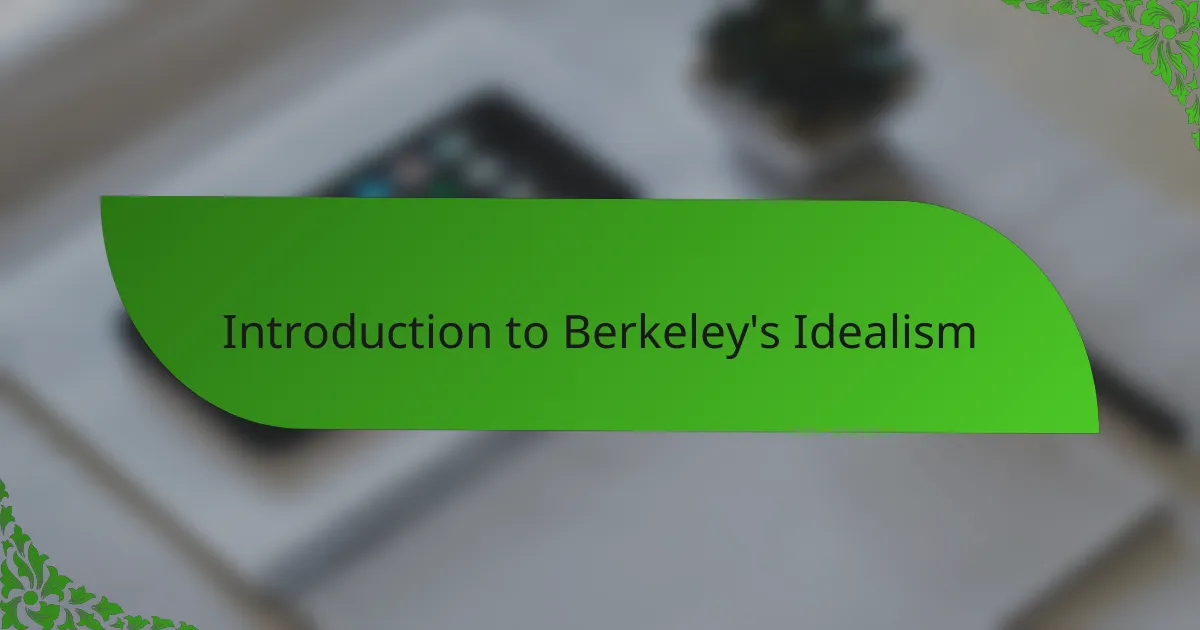
Introduction to Berkeley’s Idealism
Berkeley’s idealism, as I first encountered it, felt both surprising and strangely intuitive. The central idea—that objects only exist as perceptions in our minds—prompted me to question everything I took for granted about reality. Could it really be that what I hold in my hand owes its existence solely to my perception of it?
At times, grappling with Berkeley’s assertion that “to be is to be perceived” challenged my sense of certainty. How could something exist independently if it vanished from my awareness? I remember moments of both fascination and frustration wrestling with this idea, wondering whether it diminished or enriched the world I experience.
This perspective also invited me to consider the role of the mind, not just as a passive receiver, but as an active participant in creating reality. Was Berkeley suggesting that reality is fundamentally mental? That thought alone reshaped the way I approached not only philosophy but everyday life.
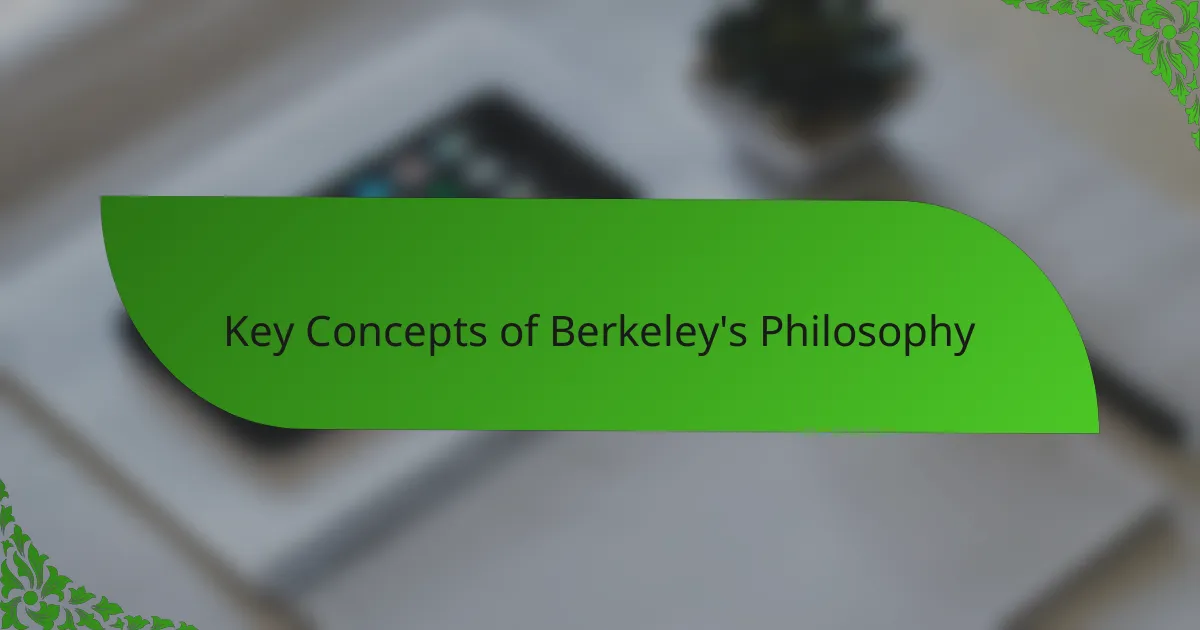
Key Concepts of Berkeley’s Philosophy
One concept that really struck me was Berkeley’s rejection of material substance. He argued that what we call “matter” doesn’t exist independently of perception. At first, I found this unsettling—how could the chair I sit on lack material reality? But then I realized Berkeley wasn’t denying the chair’s existence; he was shifting the focus to how that existence depends entirely on being perceived.
Another key idea I wrestled with was the notion of God as the ultimate perceiver. Berkeley claimed that even when no human mind is looking, objects continue to exist because God constantly perceives everything. This concept brought me comfort and a new perspective on permanence, making me rethink the relationship between faith and philosophy in a deeply personal way.
Finally, his emphasis on ideas as the fundamental units of existence made me appreciate the active role of the mind. Berkeley suggested that all we ever know are our perceptions or “ideas,” which shaped how I understood knowledge itself. It led me to question: if our reality is built from ideas, what does that mean for truth and certainty? Wrestling with that question still feels both challenging and exciting.
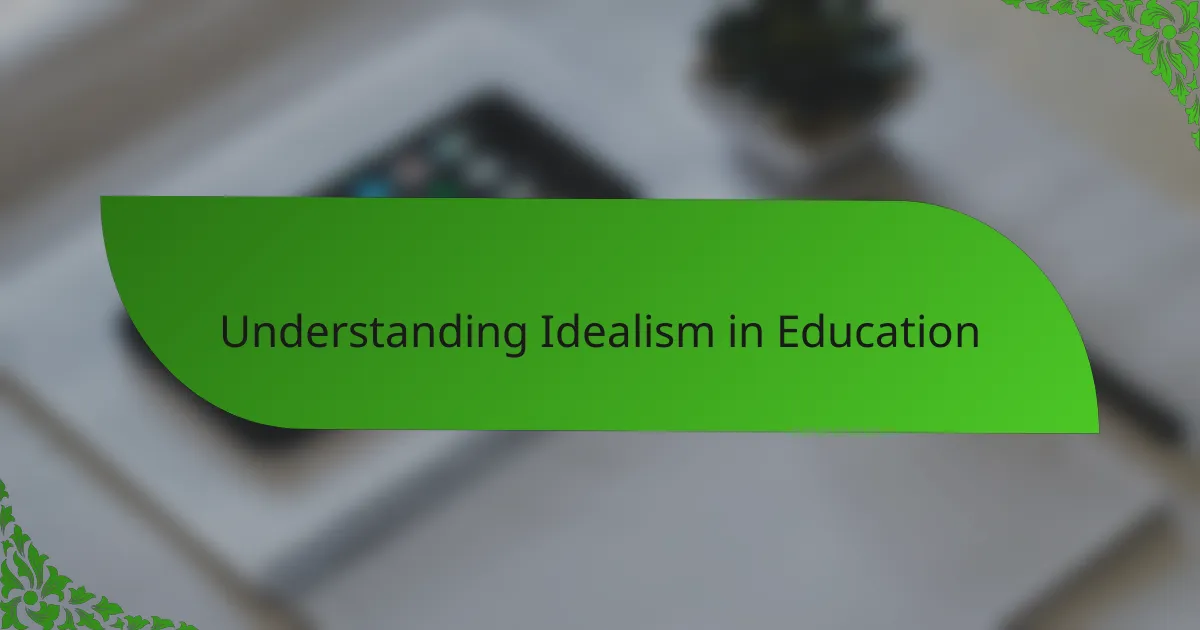
Understanding Idealism in Education
When I first tried to apply idealism to education, I realized it pushes us to rethink what learning really is. If knowledge is rooted in ideas and perceptions, then education becomes less about transferring facts and more about nurturing how we experience and interpret those ideas. This shift felt refreshing—like opening a door to a more active, engaging process where the mind is central, rather than ideas simply being handed down.
I also found myself questioning the role of the teacher through Berkeley’s lens. Are educators merely conveyors of material facts, or do they shape the reality students come to know by guiding their perceptions? This struck me as deeply empowering but also a big responsibility, since the reality students build depends on how they are taught to perceive and understand the world.
At times, this perspective made me wonder: if everything depends on perception, how do we ensure a shared reality in education? The idea that knowledge exists as mental constructs highlighted for me the importance of dialogue and interaction. It isn’t just about solitary understanding but about creating a common ground where minds connect and ideas come alive, making learning a truly collaborative experience.
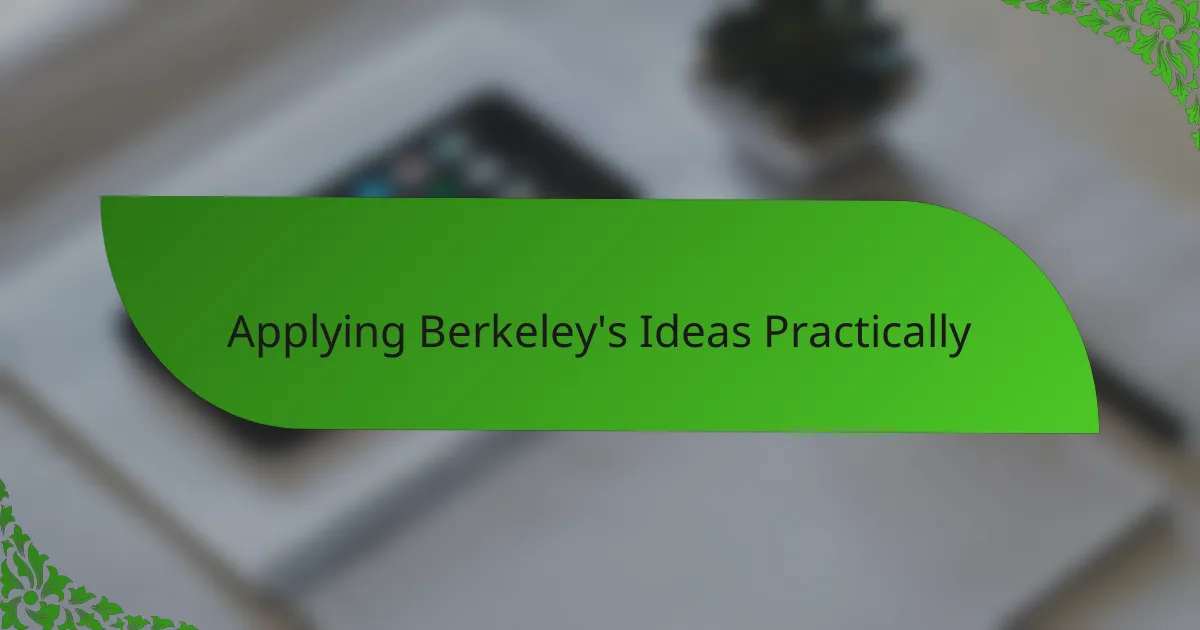
Applying Berkeley’s Ideas Practically
Applying Berkeley’s idealism practically felt like stepping into a new way of experiencing everyday life. I found myself more mindful of how my perceptions shape my reality—when I really focused on this, even simple moments took on a vividness I hadn’t noticed before. Have you ever paused to wonder if what you see is truly “out there” or just part of your mind’s ongoing activity? For me, embracing this question transformed routine experiences into something almost magical.
One challenge was applying Berkeley’s idea that objects exist only when perceived, especially in social contexts. How do we acknowledge the reality of others’ experiences if everything depends on individual perception? This led me to value empathy more deeply, realizing our shared reality is a continuous interplay of minds perceiving each other’s ideas. In practical terms, it made conversations feel richer and more meaningful because I saw them as moments where mutual realities intersect.
At work, I experimented with this perspective by consciously shaping how I present information, knowing that how people perceive it influences their reality. This wasn’t always easy—I had to balance clarity with awareness of others’ viewpoints—but it increased my appreciation for communication’s power. Applying Berkeley’s idealism taught me that perception isn’t passive; it’s an active process that creates the world we engage with every day.
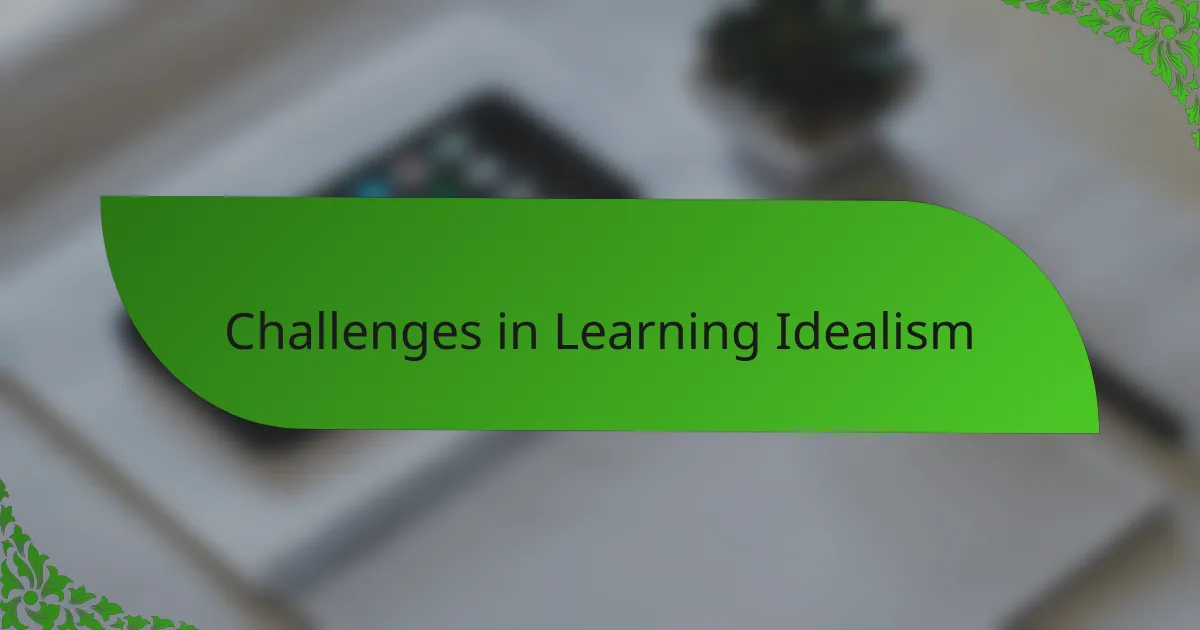
Challenges in Learning Idealism
Learning Berkeley’s idealism wasn’t a smooth ride for me. At first, the idea that objects depend entirely on perception felt almost impossible to grasp—like trying to hold water in my hands. I kept asking myself, “If the chair disappears when I’m not looking, what does that say about its reality?” That constant questioning sometimes led to confusion, but also a deeper curiosity.
One of the hardest parts was untangling my instinctive belief in a physical world that exists independently of me. Letting go of that seemed like losing a piece of stability I had always counted on. I remember moments of doubt where Berkeley’s philosophy felt almost too abstract, pushing me to rethink not just what’s real, but how I even know anything at all.
Another challenge came when trying to explain these ideas to others. How do you share a belief that the world’s very existence hinges on perception without sounding like you’ve lost your grip on reality? This struggle made me appreciate how radical Berkeley’s thoughts are, and how much patience and openness they demand—from both myself and anyone willing to engage with idealism seriously.
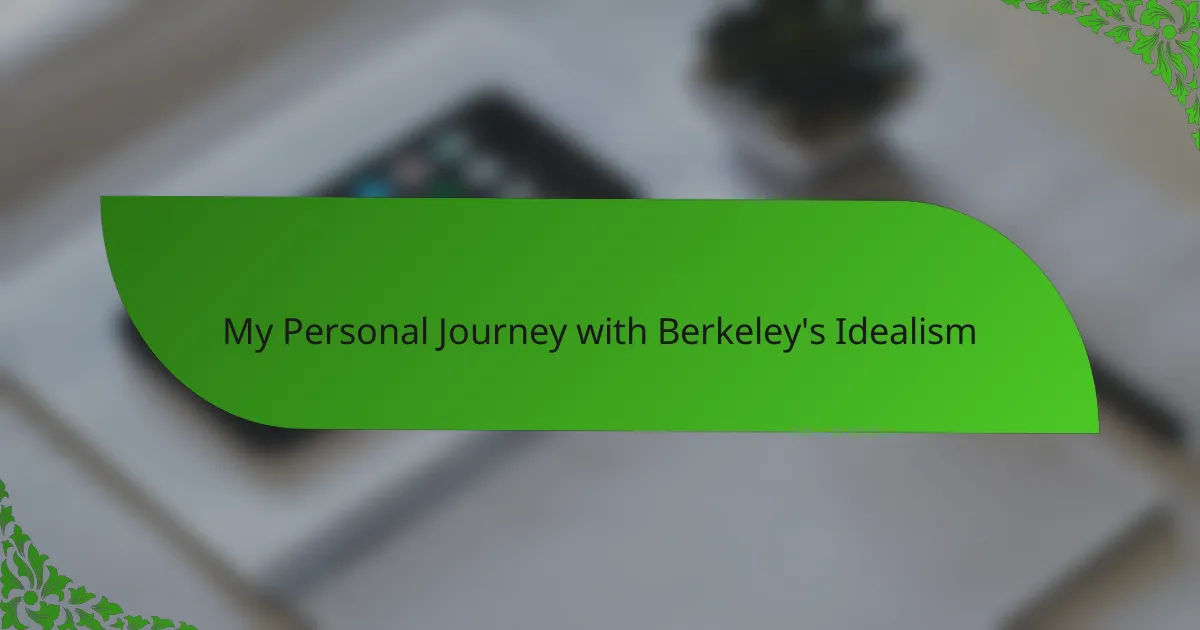
My Personal Journey with Berkeley’s Idealism
Exploring Berkeley’s idealism felt like stepping into a world where reality was more fragile and fascinating than I had imagined. I often found myself staring at everyday objects, questioning whether they truly existed apart from my perception. It was disorienting but also oddly freeing to think that the world’s solidity depended on the mind’s attention.
Sometimes, this journey made me reflect on my own awareness and how easily I take it for granted. Have you ever caught yourself doubting whether a moment or object would persist without your noticing it? That question became a personal meditation, reminding me how deeply intertwined perception and existence are in Berkeley’s view.
Yet, I also encountered moments of resistance. Letting go of the idea that a material world exists independently challenged not just my intellect but my comfort. Despite that, embracing Berkeley’s idealism expanded my understanding of reality—from a fixed backdrop to a living, mental interplay shaped by perception and, ultimately, by the continual act of being perceived.

Lessons Learned and Future Insights
Reflecting on my encounter with Berkeley’s idealism, I realized how it reshaped my understanding of reality and perception. One lesson that stands out is the fluidity of what we consider “real.” I started asking myself, how stable is the world if its existence depends so intimately on being perceived? This question kept nudging me toward a more flexible mindset, one that embraces uncertainty rather than fears it.
Another insight came from recognizing the active role our minds play, not just passively receiving but constantly shaping the world we inhabit. This shift made me more attentive to my own perceptions and the stories I tell myself about reality. It also led me to wonder: can we cultivate a shared understanding if each mind uniquely constructs the world? That thought opened up a whole new realm for how I think about communication and empathy.
Looking ahead, Berkeley’s idealism invites me to continually explore how perception influences knowledge and existence in education and everyday life. I’m curious about how this perspective might help us foster deeper connections and more meaningful learning experiences. Could embracing mental interdependence be the key to richer dialogue and collaboration? This question fuels my ongoing journey with idealism, blending philosophical reflection with practical application.